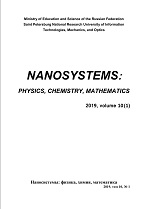|
Encapsulation of iron atoms between fragments of graphene planes
A. V. Siklitskayaa, V. I. Ivanov-Omskiib, M. S. Chekulaevb, S. G. Yastrebovb, R. Smithc, A. Slavd, C. Morosanud, S. V. Kozyreve
a Institute of Theoretical Physics, University of Warsaw, Warsaw, Poland
b Ioffe Institute, St.Petersburg, Russia
c Loughborough University, Department of Mathematical Sciences, Loughborough, United Kingdom
d National Institute of Materials Physics, Bucharest, Romania
e Center for advanced studies, Peter the Great St.Petersburg Polytechnic University, St.Petersburg, Russia
Abstract:
In this paper, we apply results of analysis of the Raman spectrum from an amorphous carbon film modified with iron ($a$ – $C$ : $Fe$) which leads to construction of clusters containing fragments of graphene and a layer of iron atoms. Such clusters may be candidates for the role of microwave radiation absorbers. For the Raman experiments we performed deposition of a thin film of $a$ – $C$ : $Fe$. Details of the film deposition process, together with the corresponding Raman experiments are presented in this paper. Comparison with a literature model was performed for the intensity ratio of the maxima for specific Raman bands, using the letter $D$ to represent “disorder” and the letter $G$ to represent “graphite”. Comparison gives evidence for the existence of nanosize fragments of graphene embedded in an amorphous matrix of the $a$ – $C$ : $Fe$ film. The diameter of the fragments is predicted to attain a value of about 1.2 nm. Moreover, in a comparison with experimental data for defective graphite, the position of the maximum of the $D$ band for $a$ – $C$ : $Fe$ appeared to be red shifted. This could support the proposition that damping of Raman-active oscillations occurs by an electron gas in fragments of graphene after introduction of iron, e.g. after intercalation. On the basis of these estimates, we modeled a symmetrical polycyclic aromatic hydrocarbon having a similar size and converted it into fragment of a graphene plane by removal of hydrogen atoms occupying the edge states. To preserve symmetry, we placed atoms of iron on top of the fragment, situating them exactly above the centers of hexagons at a certain distance and placed another fragment of graphene on the top of the iron atoms, symmetrically. For a distance of 2.52 Å between the centers of the hexagon and the iron atom, distortions of carbon-carbon valence bonds and angles were found to be minimal, as shown through optimization of the system's geometry using the Avogadro molecular editor. This result supports an hypothesis of graphene fragments during the growth of an amorphous carbon film modified by simultaneous addition of a dopant metal such as iron. This example may illustrate the stability of a two-dimensional electron gas confined between the fragments.
Keywords:
graphene, iron, intercalation, carbon, nanoclusters, encapsulation.
Received: 01.10.2015
Citation:
A. V. Siklitskaya, V. I. Ivanov-Omskii, M. S. Chekulaev, S. G. Yastrebov, R. Smith, A. Slav, C. Morosanu, S. V. Kozyrev, “Encapsulation of iron atoms between fragments of graphene planes”, Nanosystems: Physics, Chemistry, Mathematics, 6:5 (2015), 680–688
Linking options:
https://www.mathnet.ru/eng/nano981 https://www.mathnet.ru/eng/nano/v6/i5/p680
|

| Statistics & downloads: |
| Abstract page: | 57 | | Full-text PDF : | 19 |
|




 Contact us:
Contact us: Terms of Use
Terms of Use
 Registration to the website
Registration to the website Logotypes
Logotypes








 Citation in format
Citation in format 